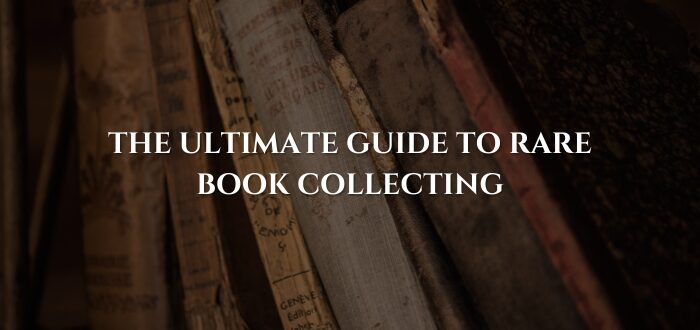The Ultimate Guide to Rare Book Collecting
Welcome to the enchanting world of rare book collecting. For those who cherish the smell of old pages and the charm of bygone eras, rare book collecting is more than just a hobby—it’s a passion. Antique book collecting invites you into a world where literature meets history, where each volume can be a time capsule of cultural, intellectual, or artistic importance.
But collecting rare books isn’t just about acquiring old books. It’s about understanding what makes a book rare or valuable, the factors involved in identifying rare books, sourcing rare books and preserving these literary treasures.
In this rare book collecting guide, we’ll walk you through everything from starting a rare book collection to identifying key features that determine its value and where to source them. Whether you’re starting a collection or refining a seasoned one, this guide will help you build knowledge and confidence.
Also Read: Allure of Vintage Books
What Makes a Book “Rare”?

Not all old books are rare, and not all rare books are old. So, what gives a book “rare” status?
Here are the key factors that make a book rare and valuable:
-
Scarcity
If only a limited number of copies exist—especially of the first edition or first printing—the book becomes significantly more valuable.
-
Historical or Cultural Significance
Books that marked pivotal moments in science, art, politics, or religion tend to carry more weight in the collector’s market.
-
Condition
Tears, missing pages, brown spots on the pages, or detached bindings can drastically reduce a book’s value. On the other hand, pristine or near-mint condition books fetch premium prices.
-
Edition and Printing
A first edition, first printing of a major work is often considered the holy grail. Learn to distinguish between reprints and true firsts.
-
Provenance
Ownership history, author inscriptions, or notable bookplates can elevate a book’s rarity and desirability.
-
Age
Older books, especially those published before the 19th century, tend to be rarer and hold a greater appeal for collectors, if they also fulfil all of the above conditions.
 Rare Book Collecting Guide
Rare Book Collecting Guide
Whether you’re a passionate reader, history enthusiast, or investment-minded collector, starting a rare book collection can be incredibly rewarding. Here’s a practical, beginner-friendly roadmap to get started the right way.
-
Learn About Rare Books
Start by immersing yourself in the world of rare books. Read guides on antique book collecting, explore reputable blogs and collector forums, and join online communities. Attend rare book fairs and auctions to get a feel for the marketplace, observe how pricing works, and talk to seasoned collectors.
-
Choose a Niche or Focus
Don’t try to collect everything. Focus your collection based on your interests—whether that’s first editions, Shakespearean works, vintage romance novels, illustrated children’s books, or 19th-century travelogues. Specializing not only keeps you focused but also increases your expertise over time.
-
Set a Budget
Rare book collecting can range from ₹5,000 finds to five-figure investments. Define your budget early and stick to it. You can start small and gradually scale as you learn what holds value in your chosen niche.
-
Learn the Terminology
Understanding collector terms like “As New,” “Fine,” “Good,” or publishing phrases like “first edition,” “uncut,” “unopened” is vital. These descriptors influence value and condition rankings. Consider downloading a collector’s glossary or printing a quick-reference guide.
-
Connect with Reputable Auction Houses
Work with trustworthy rare book dealers and auction houses. Reputable sellers can guide you, especially as you learn to evaluate authenticity, provenance, and market value. Attend auction previews, ask questions, and learn the rhythm of bidding.
Also Read: Bid for Rare Books: A Guide to Literary Auction
-
Document Every Purchase
Create a digital catalogue or spreadsheet to log every purchase. Include title, edition, condition, date acquired, price, and provenance. This is crucial for tracking your investment, planning insurance coverage, and preparing for potential resale or appraisal.
-
Get Your Books Appraised
As your collection grows, seek professional appraisals to determine value. Appraisals help with estate planning, insurance, or potential auction submissions. Look for appraisers who specialize in rare or antiquarian books.
-
Beware of Fakes
Unfortunately, the rare book world isn’t immune to fraud. Be cautious of suspicious deals, especially online. Learn to spot fake editions, altered dust jackets, and facsimiles passed off as originals. When in doubt, consult an expert to ensure that the book you are purchasing is the real deal.
-
Connect with Other Collectors
Building relationships with fellow collectors is key. Join rare book clubs, attend events, or participate in online forums. Engaging with the community helps you stay updated on trends, learn sourcing tips, and discover collecting opportunities.
-
Take Care of Your Collection
Proper preservation is essential to maintain your books’ value. Store them in cool, dry conditions away from direct sunlight. Use bookends, avoid overpacking shelves, and keep books upright. Invest in archival-quality storage materials for especially fragile items.
Mistakes to Avoid as a Beginner Collector
Every collector starts somewhere, but here are pitfalls to dodge:
- Overpaying for Common Books
Not every old book is valuable. Many newcomers assume age equals worth and end up paying premium prices for books that are neither rare nor collectible.
- Ignoring the Condition of the Book
Condition dramatically affects value. Even a rare title loses appeal if it has missing pages, water damage, loose bindings, or excessive markings. Always inspect books carefully and learn to assess their condition.
- Storing Books in Damp or Sunlit Areas

Poor storage leads to mold, warping, fading, or pest damage—each of which can permanently lower a book’s value. Store books in a climate-controlled space.
- Assuming Age Equals Value
A 150-year-old book might be common and valueless, while a 50-year-old first edition of a modern classic can be highly collectible. Value is based on demand, edition, condition, and rarity—not just age.
- Neglecting Proper Cataloguing
Without a proper record, it’s hard to track what you own, what you paid, and how your collection evolves. This creates problems for insurance, appraisals, and resale.
Curate With Purpose, Collect With Passion
Rare book collecting is a thrilling hobby that offers both intellectual satisfaction and aesthetic pleasure. For newcomers, the key is to build a strong foundation—learn the terminology, understand what defines rarity, and take time to explore the genres or authors that truly fascinate you.
Start with a clear focus, set a budget you’re comfortable with, and connect with reputable dealers and fellow collectors. Over time, you’ll not only grow your collection, but you’ll also grow your expertise and appreciation for the cultural legacy bound within each book.
It can also be a rewarding long-term pursuit, with first editions and truly rare books often appreciating in value, thus blending passion with potential financial return. But most of all, it’s a hobby rooted in curiosity, care, and respect for the written word.
Building a rare book collection isn’t just about money or status—it’s about intentional, informed collecting. The best libraries are thoughtful, deeply personal, and a reflection of the collector’s soul.
So, whether you’re just beginning or expanding your collection, remember: every rare book has a journey—and now, so do you.






